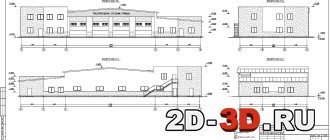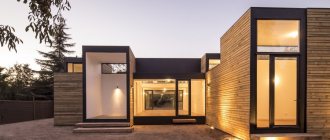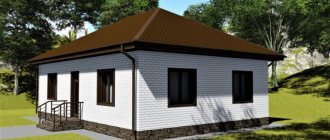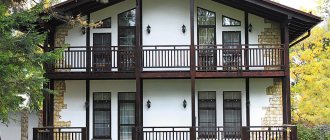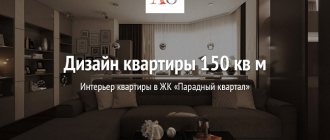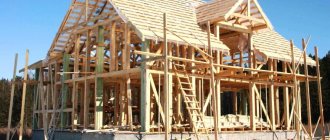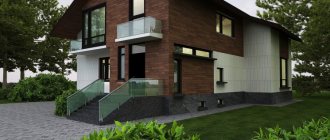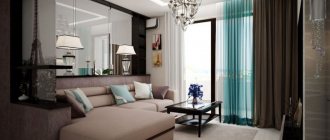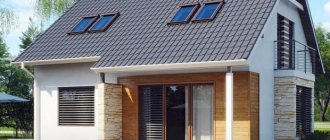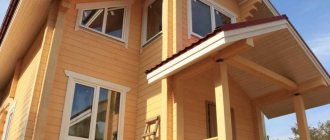In our catalog, house designs in the Russian estate style take pride of place. This is explained by the growing interest in log house construction, and logically leads to the revival of half-forgotten elements of ancient Russian architecture. Our ancestors knew how to create fabulous masterpieces from wood.
Despite the absolute external dissimilarity of each house in the catalog, they can still be divided into two large groups. One includes projects of classic Russian manor houses, the second includes ethnic stylizations such as “fairy-tale mansions”.
Russian style estate project
| House with a multi-tiered roof | House with wooden carvings | Cottage made of combined materials |
This concept usually includes a traditional, often one-story, residential building, or rather, a complex of wooden buildings along with a bathhouse, an outbuilding, a fence and a gate, forming an entire “yard.” Modern projects use several techniques of traditional Russian architecture.
- Log houses can be assembled from logs of different diameters, laid “butt to top”.
- Multi-tiered roofs of various shapes - “chest”, acute-angled, 4-pitch.
- The gables are made from the same logs as the walls - there is a feeling that they stand “by themselves”, without any support (“males”).
- Characteristic are peculiar “bay windows” - half of a hexagonal “drum” protruding beyond the wall.
- Wooden carvings are the hallmark of the house. The porch, platbands, and overhanging edges of the roof are richly decorated with figured elements.
- Open galleries “gulbishcha”, small cozy balconies are supported on carved wooden columns.
A characteristic feature of Russian houses is individuality. Each of them is unique, expressing the taste and wealth of the owners of the house. In a modern interpretation, a cottage can be built from brick in the Russian style, or with combined stone walls. The combination of materials of different textures gives the building a new look, while maintaining all the charm of a wooden frame.
Which dachas have been restored
— There are only a few cases where restoration was carried out. For example, two dachas on Morskaya Street in Komarovo: Villa Reno and Yukhnevich’s dacha, both very skillfully restored. Also Sandin’s dacha on Lieutenantov Street (the Sobaka.ru publication spoke in detail about this house).
These are mainly private houses. And it all depends on the person who buys [such a house]. For the dacha to survive, two almost impossible things must come together: a lot of money and the understanding that you are buying a unique thing.
For example, Novikov’s dacha in Zelenogorsk was bought by a private individual, and we were very afraid that the house would perish. But it turned out that the man took up this matter, and the dacha will live on. The Scandinavia Hotel in Sestroretsk also restored two dachas.
Traditional house in Russian Terem style
| Russian chalet project | Log house in Oglo |
The first wave of interest in medieval Russian architecture arose in the 19th century, and the “pseudo-Russian style” arose on its crest. Of the house designs of Russian architects of that period, the works of Ivan Ropet, who built many “mansions” with multi-tiered turrets and carved patterns, have survived. Among the techniques of the 18th century, two stand out that can give a wooden house a particularly “fairy-tale look.”
- Russian chalet is a building with a log house that expands upward due to a gradual increase in the output of crowns (“fall”). They formed a cornice on which the roof was laid, the overhangs of which could be significantly increased. Nowadays this is a rare technique; modern houses of this type are rather a stylization on the theme of a chalet.
- A log house “in the oglo” is a connection of logs in the corners of a log house with the remainder (remember the house of “Baba Yaga”). The project of a tower in the Old Russian style in our catalog includes such rare elements: figured columns with carvings, a hexagonal glazed “lantern”.
All house designs developed by us in the Russian estate style are accompanied by a full package of architectural and constructive solutions. The attached specification of materials facilitates the work of builders and ensures that the building being constructed complies with the technical plan.
What summer residents grew on their plots and what remains of the estate parks
— Only the locals had vegetable gardens, who sold vegetables, apples, garden and forest berries to summer residents. Summer residents loved gardens. The plots included flower beds, lilac bushes, jasmine bushes, spirea and other ornamental shrubs. People tried to improve their territory.
On large estates, which were called master's dachas, a park could be set up. Therefore, now, near the Primorskoye Highway, going deeper into the forest, you can find tree species that are completely foreign to these places. If you walk through the forest and see some wild rose hips, you immediately understand that here you need to look for the remains of a foundation.
For example, an absolutely stunning park belonged to the supplier of the court of His Imperial Majesty, Hermann-Friedrich Eulers. He had a large estate outside Terijoki, now it is Ushkovo. On the site, he built several summer cottages for himself and his children and created a landscaped park. But now there is practically nothing left of it.
One can also recall Villa Reno, which before the revolution belonged to the gunsmith Ivan Chizhov. He built a park with paths and fountains. Now on the site of the upper part of the park there is private property, and below there is a specially protected territory “Komarovsky Coast” with an eco-trail. In another part of Kellomäki there was a boarding house “Quiet Corner”. There was a river flowing there and there were ponds with walking paths around them.
Energy
Relying more on myself than on government help (although I don’t refuse, I don’t refuse), I plan to supply electricity to my house from a solar panel. They have already become less expensive, and by 2011 they will become even cheaper. Although my son (a physicist and programmer) convinces me that if there is a horse on the farm, then other energy sources are not needed. The horse rotates the generator (it still needs to move), the energy is stored in the battery. The plan is daring, but why not implement it to the delight of the children. Although the main thing is to learn not to waste extra energy. You don't need a refrigerator - there will be golbets. You don't need a TV - you just don't need it. A laptop and a modem (how can you live without the Internet?) don’t waste much energy. Energy-saving lamps are very economical - here I only support Medvedev. Wash? Don't get dirty. Nowadays washing machines have spoiled us greatly; we simply don’t take care of our clothes. Although in existing settlements, many settlers continue to use washing machines (they want to make women’s work easier), and they purchase gasoline generators specifically for this purpose (and for using power tools). I think this is reasonable, although it does not negate everything said above about frugality. A complete set of autonomous power supply system based on solar panels costs 120 thousand rubles. The kit includes solar modules made of monocrystalline silicon 80 W (8 pcs.), MPPT charge controller 24V\60A, stationary gel batteries 12V\200Ah (4 pcs.), pure sine inverter 220V\1.5 kW SIM-1500P. A gasoline power plant today costs approximately 26 thousand rubles. Total 146 thousand rubles. The price is considerable, but if I rent out my two-room apartment for at least 6 thousand rubles. per month, then in 2 years I will receive my “infrastructure”. And I am not afraid of any Chubais, no increase in tariffs.
How the website terijoki.spb.ru appeared
— The site was created in 2000 by two programmers, brothers Alexander and Mikhail Bravo, and local historian Vladimir Kotlyar. They traveled along the Karelian Isthmus and talked about their findings. Visitors to the site supplemented these stories with their own observations, and thus the local history focus of the site was formed.
In 2010, quite a lot of people came to the project and began working specifically on dacha areas. Someone took photographs, someone sat in the archives, someone provided old postcards from their collection. In general, it turned out to be a full cycle of research work from a discovery to an article, book or report at a scientific conference.
There are quite a lot of researchers and visitors to the site who add information on numerous forums, but the person who deals with the site on a daily basis - and not only is a researcher himself, but generally keeps everything in his head - is the only one, this is Alexander Evgenievich Bravo. He, in fact, is the engine and soul of the entire project.
The site is volunteer and has never received any grants or donations from anyone. Everything is done on a voluntary basis. All information that is put on the site is checked and double-checked: we work only with archives and only with verified information. Sometimes we even hold the information for a while until we receive confirmation.
I started working on the site in 2010. Then my friend and I took a lot of photographs of Komarovo and came to Alexander Evgenievich with a proposal to post all these photographs on the website and try to figure out what was there. But research on Komarovo, naturally, was carried out before us. For example, a lot of work was carried out in the Komarovskaya Library by its head, Elena Arkadyevna Tsvetkova, and the director of the public local history museum, Irina Aleksandrovna Snegova. And municipal deputies helped a lot, which is actually rare.
When the site began to unfold, the descendants of summer residents made themselves known, sharing their family archives. In addition to St. Petersburg, they write from different cities of Russia, from Finland, Australia, and Canada.
We can say that now a kind of local history boom has begun - excursions are very popular, books are selling like hot cakes, people are independently exploring the places where they vacation. Therefore, all the information that is posted on the pages of the site is in demand.
Money
A question that is not directly related to the topic of building a family estate, but if I bypass it, practitioners will consider the idea a beautiful fairy tale. To begin with, the estate saves a lot. Food, housing and communal services, medicine. Some families spend half their budget on medicines, but my children spent every summer with their grandmother in the village - they still don’t know where the clinic is. And yet money is needed. For gasoline, clothes, tools and the like. According to the director of the Center for Regional Development, Viktor Mikhailovich Minin, in the near future the most in demand in the world will be food products and educational services. I won’t even explain the benefits of eating without preservatives - you know this very well, but you just didn’t know where to get it. One cedar tree can produce up to 1 ton of nuts per year; today a pine nut costs 200 rubles/kg. I have already planted 10 cedars. In a good year, this will give a profit of up to 2 million rubles. It seems to me that no bank is capable of providing such a return on investment. Moreover, I will receive this money regardless of whether there is a dollar or not, what the euro exchange rate will be, whether a single currency of Russia, Kazakhstan and Belarus will be created, etc. Of course, cedars will begin to bear fruit in 20-25 years, but I’m not the only one who wants to have their own cedar. So I planted a bed of real Siberian cedars (friends from Khanty-Mansi Autonomous Okrug sent me nuts), and the seedlings will be ready in the fall. Now about education... A new era is coming, and in it people will not live as before, different knowledge and skills will be required. The Design and Analytical Note of the Innovative Development Club of the Institute of Philosophy of the Russian Academy of Sciences states: “Humanity is in a state of deep and irreversible civilizational transformation. It is in Russia that there are opportunities for the development and use of socio-humanitarian technologies of innovative development (the seventh technological order), which will create a constructive way out of a potentially destructive situation into a qualitatively new, “higher” state of human evolution. Alternative globalization will occur through the formation of complexly organized environments of “quasi-autonomous social formations”, focused on modeling and “cultivating” various forms of life activity on the planet, with a focus on the preservation and development of sociocultural diversity, on the dominance of spiritual needs over material ones, on creativity as the leading form of human activity , to create new mechanisms of economic relations, to form a new planetary ethic of cooperation, mutual responsibility, peace and justice.” If this philosophy is expressed in simple words, then eternal values will again be in demand - how to build a house, plant a tree, how to give birth and raise healthy children. How to live peacefully and in the world. Our settlement is one of these “quasi-autonomous social formations” in which this knowledge is mastered and rediscovered in order to pass it on to those who will come to earth after us. We understand this and are preparing for this quite seriously. And everything I build is not only functional objects, but also life-size teaching aids. Well, specifically for me it’s even easier. Last year, during my long absence to the Urals, we at the editorial office already tried the option of remote work via the Internet. And this year, although I am leaving for the estate until the fall, I am not saying goodbye. An Asus laptop and a Megafon modem will allow me to work as if I were in the next room (we often communicate with the next room through the Mail agent). I will describe the progress of the plan in the Diary of my Family Estate. And I am ready to discuss all other questions regarding Family Estates on the forum of the website www.tartaria.ru.
